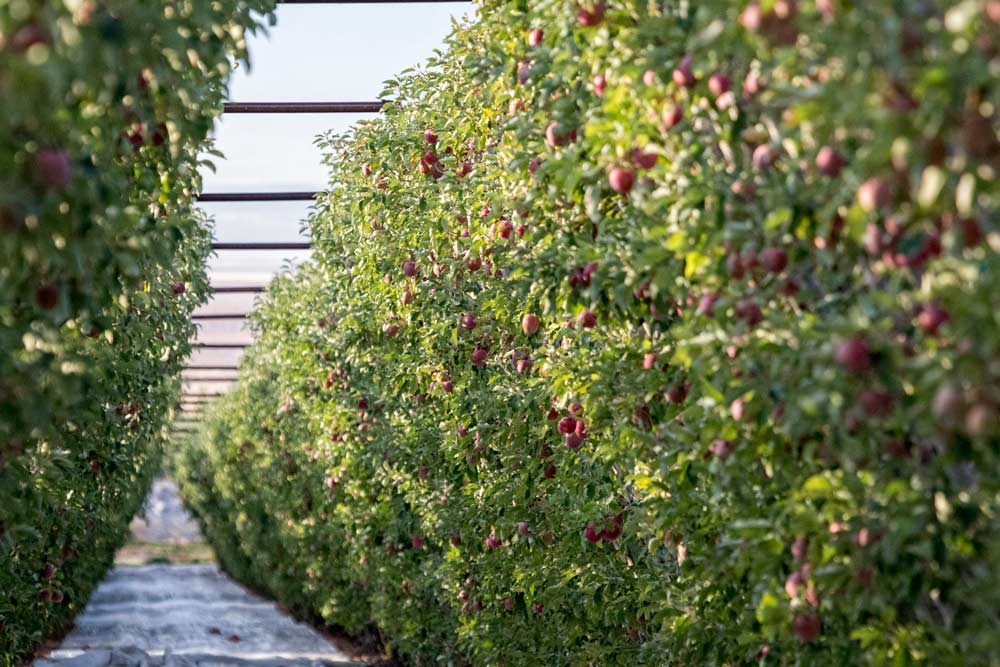
With 41, 000 acres and 32 million trees, Galas now make up the most apple acreage in Washington. (TJ Mullinax/Good Fruit Grower)
Tree fruit and grape growers in Washington have new planning tools when making decisions about what to plant and what to take out.
The U.S. Department of Agriculture has released results from grower surveys that provide a glimpse into the shifting varieties, densities and trends of the tree fruit and grape industries.
“It helps growers make some educated guesses about what they should be planting,” said Jon DeVaney, president of the Washington State Tree Fruit Association.
The Yakima-based group teamed up with the Washington Wine Growers Association to commission the surveys, conducted by the USDA’s National Agricultural Statistics Service. See the survey results at bit.ly/acreage-survey.
Among the tree fruit findings:
—Apples increased their footprint for the first time in 18 years. Since 2001, apple acreage has inched downward as growers removed older trees and replaced them with high-density orchards that produced much more volume per acre. Since the previous survey in 2011, however, apple acreage jumped roughly 7 percent to 179,000 acres. Not surprisingly, Honeycrisp showed the largest jump of varieties, increasing from 9,000 acres to 23,000.
—Increasing density is still the story, as it has been for decades. Trees planted in 1986 or before stand at roughly 410 per acre compared with an average of roughly 1,142 for those planted in 2016.
—Tree density is not equal geographically either. Apple trees stand at 825 per acre in the Columbia Basin, where most of the state’s newer acreage has been planted. That’s compared to 571 and 690 trees per acre, respectively, in the veteran regions of Wenatchee and the Yakima Valley.
—Crop volumes undoubtedly will increase if the number of young trees is any indication. Of Washington’s 126 million apple trees, almost 20 percent have yet to bear fruit. Of course, that won’t equate to a linear 20 percent jump in production because older trees will likely be taken out to make way for some of that new production, DeVaney cautioned.
—Gala is the most common variety in terms of acreage at 41,000 acres and 32 million trees.
—Cherries have shown growth in acreage since 1986 but slower growth since 2001 than before.
—Cherries also are being planted more densely but not nearly as much as apples. Cherry densities rose from 176 trees per acre in 1986 to 323 last year.
DeVaney expects growers and marketing agencies to use the figures for projections and modeling, but he warned against drawing one-for-one predictions about crop size based on acreage or number of trees. While trees planted at higher densities yield more fruit per acre, each tree is smaller and therefore holds less fruit than the larger trees of the past, planted at lower densities. Meanwhile, all varieties produce at different volume levels.
Interactive Maps
Grapes
In Washington vineyards, the survey showed overall acreage growth for wine grapes, surprising nobody. It’s up to 55,000 acres now.
Cabernet Sauvignon has led the charge, skewing Washington hard toward the red side of the variety spectrum at 65 percent. It wasn’t that long ago, 2006, that the state had a relatively even red-white split. Market demands are driving the change, said John Derrick, vice president of vineyard operations for Mercer Ranches north of Prosser.
“This shift took us from being close to in balance on reds and whites varietal acreages to heavily favoring the red varietals,” said Derrick, also a Washington Wine Growers Association board member. “In the Horse Heaven Hills, where a lot of new planting has occurred, it is dominated specifically by Cabernet Sauvignon.”
The survey broke down acreage by American Viticultural Area. Derrick advised growers to base their future plans on making sure a variety fits with those appellations rather than past performance statistics.
And as a final word, Derrick added, “Not in the survey, but I would highly advise, do not plant without a contract.” •
Links to explore our interactive orchard graphics (if they do not load)
by Ross Courtney






Leave A Comment